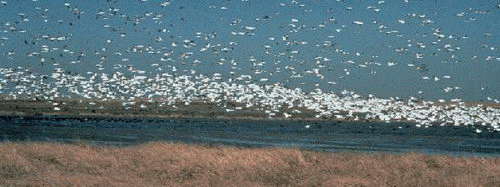May 8, 2007 feature
Animal communication plays important role in pattern formation

The way that a flock of birds flies or a school of fish swims may involve more than individuals simply judging the distance between themselves in the group. Recently, scientists from the University of Alberta have shown that a multitude of complex animal patterns can be modeled by accounting for the many ways that different species can communicate with each other.
“People have always been fascinated with the patterns displayed by different animal aggregations, such as milling schools of fish, and flocks of birds that suddenly change direction, and have tried to understand them,” UA researcher Raluca Eftimie explained to PhysOrg.com. “Our mathematical model suggests that if we want to better understand animal group patterns, we should focus on how animals communicate.”
In their paper in PNAS, Eftimie and coauthors Gerda de Vries and Mark Lewis explain that, while pattern formation is one of the most studied phenomena of animal groups, current models don’t fully account for the groups’ social interactions, and hence overlook a variety of patterns.
The scientists present five models describing how animals may receive communication signals, and discuss how signal reception affects the formation of different patterns, both moving and stationary. In doing so, the scientists’ model not only explains five known group patterns, but also reveals five previously unknown patterns. The scientists also suggest that many more exist.
“These patterns were obtained through numerical simulations, and they are particularly important from a mathematical point of view,” Eftimie said. “These types of patterns were not observed with previous mathematical models. That is why this model is so important: by displaying so many patterns, some of them already observed in nature, it actually opens a door to further understanding what causes these patterns.”
The scientists’ five animal communication models that influence pattern formation depend on how an animal can receive signals from its neighbors, with the different signals being attractive, repulsive, and alignment forces. As the scientists explain, attractive forces work at long ranges, repulsive forces at short ranges, and alignment forces at intermediate ranges.
The five models differ because, for example, not all animals can receive signals from neighbors in front, behind, or moving away from themselves, resulting in different individual reactions and thus different patterns.
For instance, in Model M3, animals can only receive signals from individuals in front of them. This means that individuals at the edge of the group that are facing away can leave the group and won’t return, since they don’t receive information from behind. This is called the feathers pattern, and is one of at least three patterns that M3 communication can result in.
In an example from another model, M4, individuals can receive signals from other animals ahead or behind—but only if those animals are moving toward the reference individual. In this case, if the individuals in front are moving faster than those behind them, they can lose the group. But later, the group often picks them back up. This behavior can result in expanding and contracting groups called breathers as well as traveling breathers (one of the previously unknown models, and one of at least seven models that M4 behavior can exhibit). The scientists suggest that schools of fish and flocks of birds may use breather behavior as an antipredatory technique.
A third interesting example explaining the significance of communication is Model M5, where individuals can only receive signals from animals that are ahead and moving toward them. This behavior, which is seen in Myxobacteria, can manifest in a ripple pattern when two groups approach each other. While a few individuals will continue moving in the same direction, most will turn around due to repulsive forces. This behavior gives the impression that the two waves pass through each other.
Because in the different models, different amounts of information are received by an individual, the scientists could also infer that the amount of information received seems to influence the strength of the alignment force required to produce a group pattern. In other words, animals that can receive signals from more directions can align more easily. While a somewhat intuitive concept, this model is the first that has related communication and pattern formation, resulting in the discovery of new models and, more importantly, a path for further investigation.
“There are probably many species whose mechanisms of pattern formation are not understood,” Eftimie explained. “But also there are many questions regarding the communication mechanisms these animals use. I think that we are still far from being able to quantify every group pattern. This requires an active collaboration between scientists who construct mathematical models and scientists who can test these models through different biological experiments.”
She added that understanding group patterns can lead to some interesting applications, as well.
“The study of animal pattern formation has not only theoretical significance, but also some practical applications,” she said. “For example, understanding locust aggregations can help manage and control this species' outbreaks. Also, understanding schooling behavior can be useful in establishing fishing strategies.”
Citation: Eftimie, R., de Vries, G., and Lewis, M. A. “Complex spatial group patterns result from different animal communication mechanisms.” Proceedings of the National Academy of Sciences. April 24, 2007, vol. 104, no. 17.
Copyright 2007 PhysOrg.com.
All rights reserved. This material may not be published, broadcast, rewritten or redistributed in whole or part without the express written permission of PhysOrg.com.





















